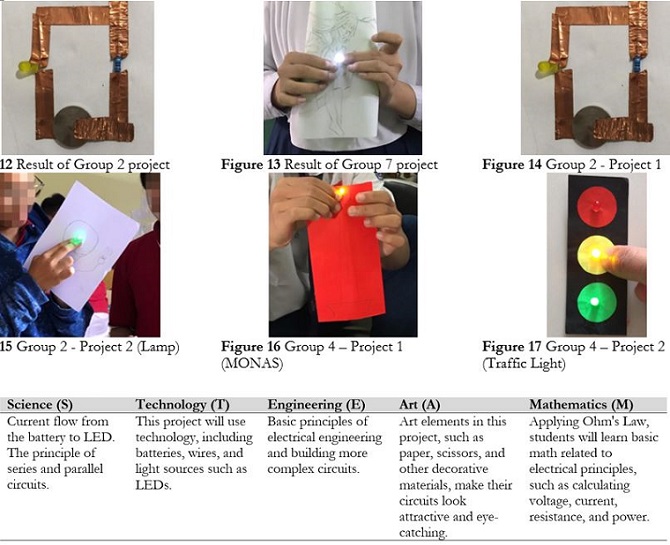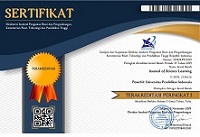
Paper Circuit Project-based STEAM Learning to Enhance Student Understanding and Creativity
Abstract
Students believed physics was one of the most challenging sciences in education, and their interest in learning physics was lacking. Therefore, this study aims to enhance students' understanding and creativity in the STEAM learning system on electricity by creating a project (Paper Circuit) using the students' creativity at the junior high school level—quantitative research with a pre-experimental design used for this study. The population is 8th grade and 9th grade (50 students adapted to the curriculum used in the school) in one of the Junior Secondary Schools located in Bandung and Cimahi, Indonesia. The data is obtained from the pretest-posttest results, which show that the average pre-test score was 57.04 and the post-test score was 76.64. The nonparametric test was tested using the Wilcoxon test to measure student understanding. The results from e Wilcoxon are .000, which shows sig. <0.05, which means there is a significant difference between pre-test and post-test. Students' creativity is obtained from the Creativity Product Analysis Matrix (CPAM), and the result for Project 1 is 73.71%, categorized as enough, and Project 2 is 83.13%, categorized as good. Based on the result, Paper Circuit STEAM project-based learning can enhance student understanding and creativity. STEAM project-based learning can be used as an alternative teaching strategy in junior secondary school.
Full Text:
Download PDFReferences
Aguilera, D., & Ortiz-Revilla, J. (2021). Stem vs. Steam education and student creativity: A systematic literature review. Education Sciences, 11(7). https://doi.org/10.3390/educsci11070331
Amabile, T. M. (2012). Componential Theory of Creativity. Harvard Business School, 1–10.
Anderson, L. W., & Krathwohl, D. R. (Eds. . (2001). A Taxonomy for Learning, Teaching, and Assessing. Addison Wesley Longman, Inc.
Anwari, I., Yamada, S., Unno, M., Saito, T., Suwarma, I. R., Mutakinati, L., & Kumano, Y. (2015). Implementation of authentic learning and assessment through stem education approach to improve students’ metacognitive skills. K-12 STEM Education, 1(3), 123–136.
Asghar, A., Ellington, R., Rice, E., Johnson, F., & Prime, G. (2012). Supporting STEM Education in Secondary Science Contexts. Interdiscip. J. Probl.-Based Learn.
Bazler, J., & Sickle, M. V. (2017). Cases on STEAM education in practice. IGI Global. https://doi.org/10.4018/978-1-5225-2334-5
Besemer, S. P., & Treffinger, D. J. (1981). Analysis of Creative Products: Review and Synthesis. The Journal of Creative Behavior, 15(3), 158–178. https://doi.org/10.1002/j.2162-6057.1981.tb00287.x
Boyle, J. (2021). Oceans of Inspiration: A Marine Based STEAM Project. European Journal of STEM Education, 6(1), 15. https://doi.org/10.20897/ejsteme/11356
Cao, Y., & Brizuela, B. M. (2016). High school students’ representations and understandings of electric fields. Physical Review Physics Education Research.
Christine, V., & McDonald. (2016). STEM Education: A review of the contribution of the disciplines of science, technology, engineering and mathematics. Science Education International, 27(4), 530–569.
Colucci-Gray, L., Trowsdale, J., Cooke, C. F., Davies, R., Burnard, P., & Gray, D. S. (2017). Reviewing the potential and challenges of developing STEAM education through creative pedagogies for 21st learning: How Can School Curricula Be Broadened Towards a More Responsive, Dynamic, and Inclusive Form of Education? 1–105.
Connor, A. M., Karmokar, S., & Whittington, C. (2015). From STEM to STEAM: Strategies for enhancing engineering & technology education. International Journal of Engineering Pedagogy, 5(2), 37 – 47. https://doi.org/doi: 10.3991/ijep.v5i2.4458
Creswell, J. W., & Creswell, J. D. (2017). Research design: Qualitative, quantitative, and mixed methods approaches. Sage publications.
Davies, D., Jindal-Snape, D., Collier, C., Digby, R., Hay, P., & Howe, A. (2013). Creative learning environments in education-A systematic literature review. Thinking Skills and Creativity, 8(1), 80–91. https://doi.org/10.1016/j.tsc.2012.07.004
Dawes, L., & Wegerif, R. (2004). Thinking and learning with ICT: Raising achievement in primary classrooms. Routledge.
Farwati, R., Metafisika, K., Sari, I., Sitinjak, D., Solikha, D. F., & Putra, E. E. (2021). STEM Education Dukung Merdeka Belajar (dilengkapi dengan Perangkat Pembelajaran Berbasis STEM) [STEM Education Supports Freedom of Learning (equipped with STEM-Based Learning Tools)]. DOTPLUS. https://books.google.co.id/books?id=TeIhEAAAQBAJ&hl=id&sitesec=reviews
Hake, B. J. (1999). Lifelong learning in late modernity: The challenges to society, organizations, and individuals. Adult education quarterly, 49(2), 79-90.
Hanif, S., Wijaya, A. F. C., & Winarno, N. (2019). Enhancing Students’ Creativity through STEM Project-Based Learning. Journal of Science Learning, 2(2), 50. https://doi.org/10.17509/jsl.v2i2.13271
Henriksen, D. (2014). Full STEAM Ahead: Creativity in Excellent STEM Teaching Practices. STEAM Journal, 1(2), 1–9. https://doi.org/10.5642/steam.20140102.15
Kim, D. H., Ko, D. G., Han, M. J., & Hong, S. H. (2014). The Effects of science lessons applying STEAM education program on the creativity and interest levels of elementary students. Journal of the Korean Association for Science Education, 34(1), 43–54.
Kim, S. W., Chung, Y. L., Woo, A. J., & Lee, H. J. (2012). Development of a theoretical model for STEAM education. Journal of the Korean Association for Science Education, 32(2), 388–401.
Kokotsaki, D., Menzies, V., & Wiggins, A. (2016). Project-based learning: A review of the literature. Improving Schools, 19(3), 267–277. https://doi.org/10.1177/1365480216659733
Lee, V. R., & Recker, M. (2018). Paper Circuits: A Tangible, Low Threshold, Low Cost Entry to Computational Thinking. TechTrends, 62(2), 197–203. https://doi.org/10.1007/s11528-017-0248-3
Lindberg, L., Fields, D. A., & Kafai, Y. B. (2020). STEAM Maker Education: Conceal/Reveal of Personal, Artistic and Computational Dimensions in High School Student Projects. Frontiers in Education, 5(May), 1–16. https://doi.org/10.3389/feduc.2020.00051
Meltzer, D. E. (2002). The relationship between mathematics preparation and conceptual learning gains in physics: A possible "hidden variable" in diagnostic pre-test scores. American Journal of Physics, 70(12), 1259–1268. https://doi.org/10.1119/1.1514215
Miller, J., & Knezek, G. (2013). STEAM for student engagement. Proceedings of the SITE 2013, 25–29.
Mulhall, P., McKittrick, B., & Gunstone, R. (2001). A Perspective on the Resolution of Confusions in the Teaching of Electricity. Research in Science Education.
Munandar, U. S. C. (1999). Mengembangkan Bakat dan Kreativitas Anak Sekolah [Developing Talent and Creativity of School Children]. Gramedia Widiasarana Indonesia.
Ogunleye, J. (2018). Creativity and innovation in STEM Education. https://tinyurl.com/4ce4af7xOrnstein
Ozkan, G., & Topsakal, U. (2019). Exploring the effectiveness of STEAM design processes on middle school students’ creativity. Int. J. Technol. Des. Educ.
Perignat, E., & Katz-Buonincontro, J. (2019). STEAM in practice and research: An integrative literature review. Thinking Skills and Creativity, 31, 31–43. https://doi.org/10.1016/j.tsc.2018.10.002
Permanasari, A. (2016). STEM Education: inovasi dalam pembelajaran sains [STEM Education: innovation in science learning]. Seminar Nasional Pendidikan Sains VI.
Purnamasari, I., Khasanah, I., & Wahyuni, S. (2020). Digital literacy for children based on steam in family education. Journal of Physics: Conference Series, 1464(1). https://doi.org/10.1088/1742-6596/1464/1/012032
Purwanto, M. N. (2009). Prinsip-prinsip dan Teknik Evaluasi Pengajaran [Principles and Techniques of Teaching Evaluation]. Remaja Rosdakarya.
Rahmawati, Y., Adriyawati, Utomo, E., & Mardiah, A. (2021). The integration of STEAM-project-based learning to train students critical thinking skills in science learning through electrical bell project. Journal of Physics: Conference Series, 2098(1). https://doi.org/10.1088/1742-6596/2098/1/012040
Riskawati. (2018). Uji Validitas dan Reliabilitas. Jurnal Tarbiyah: Jurnal Ilmiah Kependidikan, 7(1), 1–10.
Sanders, M. (2009). STEM, STEM education, STEMmania. The Technology Teacher, 20–26.
Sani, A., Rochintaniawati, D., & Winarno, N. (2019). Using Brain-Based Learning to Promote Students’ Concept Mastery in Learning Electric Circuit. Journal of Science Learning, 2(2), 42. https://doi.org/10.17509/jsl.v2i2.13262
Sigit, D. V., Ristanto, R. H., & Mufida, S. N. (2022). Integration of Project-Based E-Learning with STEAM: An Innovative Solution to Learn Ecological Concept. International Journal of Instruction, 15(3), 23–40. https://doi.org/10.29333/iji.2022.1532a
Taylor, C. P. (2016). Why is a STEAM Curriculum Perspective Crucial to the 21st century ? 14th Annual Conference of the Australian Council for Educational Research, August, 89–93. https://link-springer-com.ezproxy1.library.usyd.edu.au/content/pdf/10.1007%2F978-94-007-2150-0_212.pdf
Wandari, G. A., Wijaya, A. F. C., & Agustin, R. R. (2018). The Effect of STEAM-based Learning on Students’ Concept Mastery and Creativity in Learning Light And Optics. Journal of Science Learning, 2(1), 26. https://doi.org/10.17509/jsl.v2i1.12878
Wannapiroon, N., & Pimdee, P. (2022). Thai undergraduate science, technology, engineering, arts, and math (STEAM) creative thinking and innovation skill development: a conceptual model using a digital virtual classroom learning environment. Education and Information Technologies, 27(4), 5689–5716. https://doi.org/10.1007/s10639-021-10849-w
Weibert, A., Aal, K., Wulf, V., & Masrhall, A. (2016). Facilitating STEAM Learning among Children with Paper Circuit Activities. McGraw-Hill.
White, D. W. (2014). What Is STEM education, and why is it important? Florida Association of Teacher Educators Journal, 1–9.
Wittayakhom, N., & Piriyasurawong, P. (2020). Learning Management STEAM Model on Massive Open Online Courses Using Augmented Reality to Enhance Creativity and Innovation. Higher Education Studies, 10(4), 44. https://doi.org/10.5539/hes.v10n4p44
Yasin, A. I., Prima, E. C., & Sholihin, H. (2018). Learning electricity using Arduino-Android based Game to Improve STEM Literacy. Journal of Science Learning, 1(3), 77. https://doi.org/10.17509/jsl.v1i3.11789
Yazici, B., & Yolacan, S. (2007). A comparison of various tests of normality. Journal of Statistical Computation and Simulation, 77(2), 175–183. https://doi.org/10.1080/10629360600678310
DOI: https://doi.org/10.17509/jsl.v7i1.61765
Refbacks
- There are currently no refbacks.
Copyright (c) 2024 Arnie Novianti Zulkarnain, Eka Cahya Prima, Nanang Winarno

This work is licensed under a Creative Commons Attribution-ShareAlike 4.0 International License.


Jl. Dr. Setiabudhi 229 Bandung 40154, West Java, Indonesia











